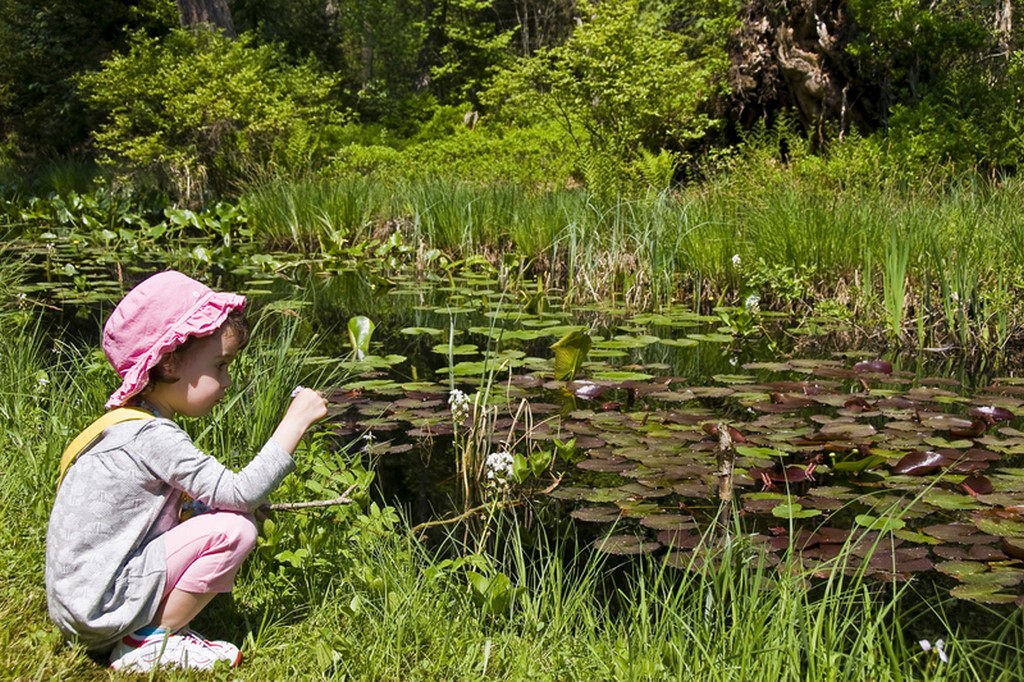Meeting Special Needs

Ponds are often valued for being uniquely calming and comforting. But for a child with autism, these watershapes can also be therapeutic in a number of ways. That’s wonderful news for these kids, Mike Gannon observes — and great for their families as well.
Ponds stocked with beautiful fish are magical – focal points for meditation, engagement, relaxation and participation in the lives of other earthly creatures.
But what we’re discovering now is that they are also therapeutic, and not just with respect to their ability to lower blood pressure: A recent report from the University of Missouri asserts that having fish or other suitable creatures as pets can be specifically beneficial for children with autism. And that’s very good news for these kids – great news, in fact.
Autism has been described in recent years as an American epidemic, with rates of incidence rising by 119 percent between 2000 and 2010 with no sign of relief in the years since. By some expert estimates, a devastating one in every 45 American children is currently affected by Autism Spectrum Disorder – a maddening number that leaves too many families struggling with the realities of raising children with unusual needs.
The research mentioned above shows that the interactions autistic children have with pets can be strongly positive – and that they occur on what, for these kids, is a higher, more engaged level. And it’s about more than cuddly kittens: Researchers say that autistic children are made mellower by fish-keeping in ways that shouldn’t be overlooked.
CALMING BENEFITS
The University of Missouri’s Thompson Center for Autism and Neurodevelopmental Disorders is looking into this phenomenon and indicates that family pets can be beneficial in the social-skills development of autistic children. In fact, children in homes with pets of any kind are more likely to engage in behaviors such as introducing themselves, asking for information and/or responding to other people’s questions.
 These basic social interactions are typically difficult for kids with autism, but pets, say the researchers, encourage them to be more assertive and engaged – a profoundly desirable outcome.
These basic social interactions are typically difficult for kids with autism, but pets, say the researchers, encourage them to be more assertive and engaged – a profoundly desirable outcome.
 What this means, of course, is that the addition of a Koi or goldfish pond into the life of a family that is coping with autism can have a significant, beneficial effect not only for the autistic child’s development, learning and behavior, but also on the entire family’s interrelationships. On a profound level, pets such as Koi and goldfish are an interest that the entire family can share in ways that we in the pond-making business might never have considered.
What this means, of course, is that the addition of a Koi or goldfish pond into the life of a family that is coping with autism can have a significant, beneficial effect not only for the autistic child’s development, learning and behavior, but also on the entire family’s interrelationships. On a profound level, pets such as Koi and goldfish are an interest that the entire family can share in ways that we in the pond-making business might never have considered.
Many children with autism are, for example, inclined to meltdowns and severe temper tantrums. During these episodes, they can become completely disengaged, are unable to focus and may become difficult to control. These incidents can occur on a regular basis, sometimes even daily, and in these times kids often will benefit from “calm areas,” designated spaces that help them regain their composure.
Koi and goldfish ponds fill this bill neatly, offering serene, soothing, familiar environments for these children. In fact, it is reported that recovery times from meltdown can be accelerated in the distracting presence of pets, including the Koi and goldfish in backyard ponds.
|
Safety First! Recent studies have also revealed that teaching autistic children to swim is of extraordinary importance because they are drawn to calming spaces and can easily find themselves seeking out closer contact by getting right into the water with their Koi and goldfish. As with any watershape where children are present, safety is the watchword! — M.G. |
We in the pond business should have a sense of this calming effect because it is so universal: Around fish ponds, all of us – autistic or not – focus our attention on the details of what we’re seeing. And few of us, without being exposed to ponds, have any idea how social Koi and goldfish are: Far from shy, they clearly recognize their caretakers and readily interact with them, even to the extent that they’re willing to be petted as part of their daily behavior.
In fact, these fish can be comically demanding when it comes to treats of food, and they will commonly accompany their caretakers as they moved around the water’s edge. With lifespans of 40 years and more and at sizes that can reach up to three feet in length with weights exceeding those of cats and small dogs, Koi and goldfish easily become beloved family pets. Their bright colors, mesmerizing swimming patterns and eager dispositions charm us all – and autistic children share that same response and attraction to these amazing creatures.
FISHING FOR CONNECTION
What for adults and many children is an uncomplicated experience of the natural world can be so much more compelling for an autistic child.
With younger autistic children, for example, Koi and goldfish ponds offer tremendous learning opportunities: Picking up the vocabulary of the pond and observing its colors are part of this as they learn about fins, eyes, scales and tails and the various hues these fish can display. And repetition of these experiences is the key to the calming effect.
Who isn’t touched when any small child points to a big, happy Koi and says “red fish”? It can’t get old, and counting fish is so much fun that Dr. Seuss even wrote a classic book about it. And again, repetition is crucial: Hanging out around a pond, counting fish, is an activity that can be recreated with every visit. Learning all the names of these pets and mastering the ability to identify differences in the colors, patterns, behaviors and physical nuances of Koi and goldfish is great mental exercise and good for all of us – but it is of special value to autistic kids.
Taking care of “Henry the Koi” is empowering; recognizing all of a pond’s Koi and goldfish by name is an incredible connection and stabilizing experience for the autistic child.
Feeding the fish is another activity that greatly engages the child and brings a new focus that guides an upset child away from a meltdown. It’s a very social activity and gives parents, adults and siblings an easy opportunity to talk with autistic children and ask them questions about their fish pond. Getting them involved in routine feedings and even in maintenance only deepens the value of these connections.
As pond professionals, we know and promote fish ponds for their overall soothing effects: They are wonderfully relaxing, with the sound and movement of the water and their ability to reflect their surroundings. It’s all about the purest sort of relaxation, and I’ll emphasize once again that all of these virtues seem to jump to a much higher level when a child with autism is involved.
And it gets better: Think about the birds that stop by to visit along with other forms of wildlife. The possibilities deepen and become more profound when frogs and dragonflies start zipping around within and above the water.
As watershapers, we all have it in us to create these serene spaces as homes for Koi, goldfish and other creatures, complete with waterfalls and rockwork and details that can be explored at leisure, day or night, through a lifetime. The fact that Koi and goldfish ponds may be one of the solutions that parents, kids and families are looking for only makes it better – not just as therapy for autistic children, but for the peace of mind of whole families.
Mike Gannon is owner and lead designer at Full Service Aquatics, a pond installation and service specialist based in Summit, N.J. A certified Aquascape contractor, he may be reached at [email protected].











